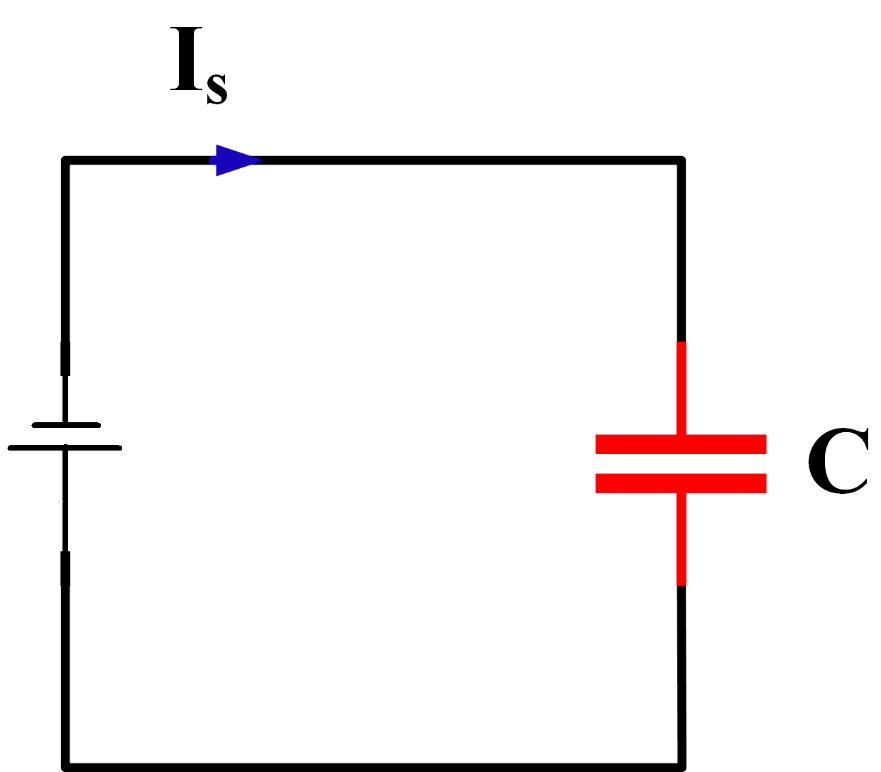
Derive the expression for energy stored in a charged capacitor.
Answer
510.1k+ views
Hint: The relation between Capacitance, charge and electrical potential. The work done to accumulate charge in a capacitor is the energy stored in a capacitor. Relation between electrical potential and work done.
Formula used: $V=\dfrac{Q}{C}$, where, V represents the electrical potential, C represents the capacitance and Q represents the charge stored in a capacitor.
The work done to move a test charge $dQ$ is given by the expression $dW=VdQ$
Also, $\int_{a}^{b}{{{x}^{n}}dx}=\dfrac{{{b}^{n+1}}-{{a}^{n+1}}}{n+1}$
Complete step by step answer:

A capacitive circuit is shown in the above figure. In a circuit, with voltage around the capacitor V, the Capacitance C is given by the equation:
$Q=CV$…(1)
Where, Q represents the charge stored in the capacitor.
Now, we want to find the energy stored in a capacitor.
According to electrostatics, the energy stored in a capacitor will be equal to the work done to move the charge into the capacitor having an electrical potential V.
Or
$dW=VdQ$…(2)
Now, for a capacitor, $V=\dfrac{Q}{C}$…(3)
So, we can put the value of V from equation (3) into equation (2).
This gives,
$dW=\dfrac{Q}{C}dQ$,
Now the total work done to move charge Q can be found by integration,
$\int_{0}^{W}{dW}=\dfrac{1}{C}\int_{0}^{Q}{QdQ}$
Now, from the integration method given in the formula used section, we can calculate the following result.
\[W=\dfrac{1}{2}\dfrac{{{Q}^{2}}}{C}\], This is also equal to the energy stored in the capacitor.
Therefore, $U=\dfrac{1}{2}\dfrac{{{Q}^{2}}}{C}$
Moreover, from equation (1), we can put ${{Q}^{2}}={{\left( CV \right)}^{2}}$
This will give us,
$U = \dfrac{1}{2}\dfrac{{{Q^2}}}{C} = \dfrac{1}{2}C{V^2}$
Additional Information: A capacitor is a device in which equal and opposite charges are separated by a distance in space.
The capacitor shown in the books is usually a parallel plate capacitor.
Cylindrical capacitors are used in many electrical devices.
The SI unit is farad. It is defined as the capacitance which stores 1 C of charge along 1 V potential difference,
Note: The value of capacitance in a parallel plate is given by $C=\varepsilon \dfrac{A}{d}$, where, $\varepsilon $is the permittivity of medium between the plates, A is the area of the plates and d is the distance between the plates. The question can also be solved by substituting the value of $C=\varepsilon \dfrac{A}{d}$, in equation (3). This will give an answer in terms of area and distance of the plates.
Formula used: $V=\dfrac{Q}{C}$, where, V represents the electrical potential, C represents the capacitance and Q represents the charge stored in a capacitor.
The work done to move a test charge $dQ$ is given by the expression $dW=VdQ$
Also, $\int_{a}^{b}{{{x}^{n}}dx}=\dfrac{{{b}^{n+1}}-{{a}^{n+1}}}{n+1}$
Complete step by step answer:

A capacitive circuit is shown in the above figure. In a circuit, with voltage around the capacitor V, the Capacitance C is given by the equation:
$Q=CV$…(1)
Where, Q represents the charge stored in the capacitor.
Now, we want to find the energy stored in a capacitor.
According to electrostatics, the energy stored in a capacitor will be equal to the work done to move the charge into the capacitor having an electrical potential V.
Or
$dW=VdQ$…(2)
Now, for a capacitor, $V=\dfrac{Q}{C}$…(3)
So, we can put the value of V from equation (3) into equation (2).
This gives,
$dW=\dfrac{Q}{C}dQ$,
Now the total work done to move charge Q can be found by integration,
$\int_{0}^{W}{dW}=\dfrac{1}{C}\int_{0}^{Q}{QdQ}$
Now, from the integration method given in the formula used section, we can calculate the following result.
\[W=\dfrac{1}{2}\dfrac{{{Q}^{2}}}{C}\], This is also equal to the energy stored in the capacitor.
Therefore, $U=\dfrac{1}{2}\dfrac{{{Q}^{2}}}{C}$
Moreover, from equation (1), we can put ${{Q}^{2}}={{\left( CV \right)}^{2}}$
This will give us,
$U = \dfrac{1}{2}\dfrac{{{Q^2}}}{C} = \dfrac{1}{2}C{V^2}$
Additional Information: A capacitor is a device in which equal and opposite charges are separated by a distance in space.
The capacitor shown in the books is usually a parallel plate capacitor.
Cylindrical capacitors are used in many electrical devices.
The SI unit is farad. It is defined as the capacitance which stores 1 C of charge along 1 V potential difference,
Note: The value of capacitance in a parallel plate is given by $C=\varepsilon \dfrac{A}{d}$, where, $\varepsilon $is the permittivity of medium between the plates, A is the area of the plates and d is the distance between the plates. The question can also be solved by substituting the value of $C=\varepsilon \dfrac{A}{d}$, in equation (3). This will give an answer in terms of area and distance of the plates.
Recently Updated Pages
A man running at a speed 5 ms is viewed in the side class 12 physics CBSE

The number of solutions in x in 02pi for which sqrt class 12 maths CBSE

State and explain Hardy Weinbergs Principle class 12 biology CBSE

Write any two methods of preparation of phenol Give class 12 chemistry CBSE

Which of the following statements is wrong a Amnion class 12 biology CBSE

Differentiate between action potential and resting class 12 biology CBSE

Trending doubts
What are the major means of transport Explain each class 12 social science CBSE

Which are the Top 10 Largest Countries of the World?

Draw a labelled sketch of the human eye class 12 physics CBSE

How much time does it take to bleed after eating p class 12 biology CBSE

Explain sex determination in humans with line diag class 12 biology CBSE

Explain sex determination in humans with the help of class 12 biology CBSE




